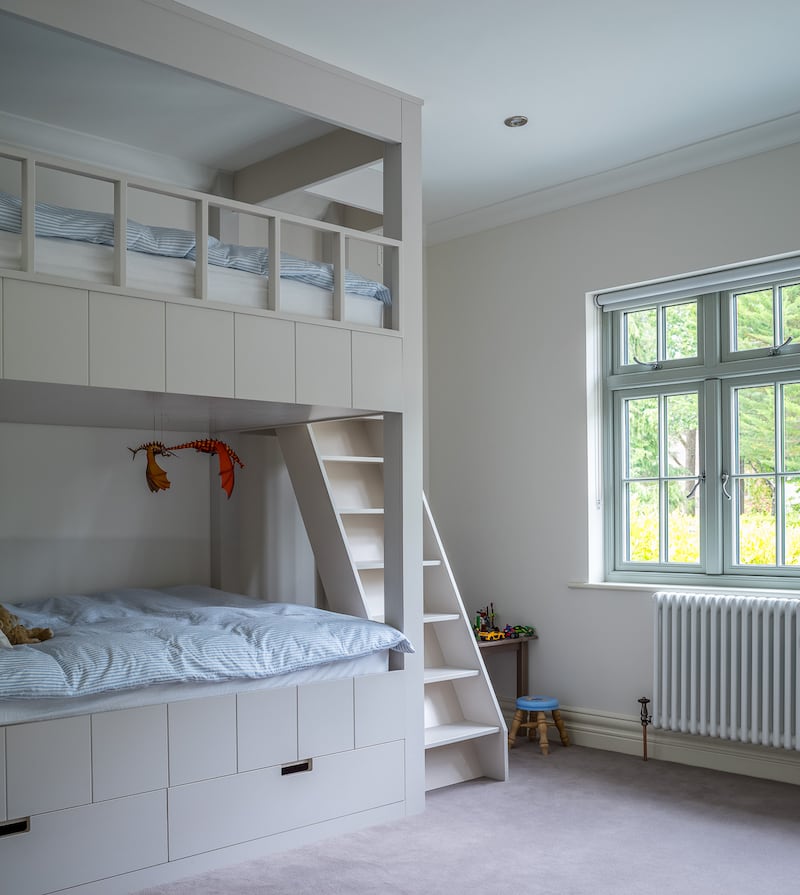Sharing a room can be one of the biggest challenges for siblings, especially if their personalities, tastes or interests differ. However, with a thoughtful and creative approach, a shared bedroom can become a space where even the most different of siblings feel at home. The key is to ensure that each child feels they have their own unique place while still fostering the idea of togetherness. Here are some clever ideas to help you design a kids’ bedroom that’s fun, functional and flexible enough for them to enjoy, regardless of their differences.
Embrace difference
Designing a shared room doesn’t mean everything has to match perfectly. Embrace your kids’ unique personalities and create two distinct spaces within the same room. This way, each child can have an area that reflects their own taste and style. Get your kids involved and encourage them to play around with ideas.
Experiment with different colours, patterns or themes for each side of the room. For example, one side could feature bold geometric shapes, while the other has soft pastels or a specific theme. The key to a successful mismatched design is choosing a common element, such as furniture style or a shared colour palette, to tie everything together. This will create harmony between their individual styles and maintain a cohesive overall design.
Create zones
One of the best ways to make a shared bedroom functional is to create distinct zones for each child, even within the same space. For example, separating the room into areas for sleeping, studying and playing can give each child a sense of personal space while still fostering a shared environment.
A New Zealander in Dublin: ‘It feels like people work to live here as opposed to living to work’
Family fallouts: ‘I can’t describe the heartache of not having a relationship with my sister’
Zach Bryan in Dublin review: Gen Z’s Garth Brooks puts on a charming – and lengthy – show
How the death of an ‘old boy from Ireland’ in London-Irish suburb sparked a misguided viral appeal
Several years ago, we worked with a client with two young boys sharing a long, narrow bedroom. The challenge was making the room work for sleeping and playing while giving each boy a personal space. Instead of treating the room as one large area, we divided it into two zones. One end of the room was dedicated to sleeping, painted in a deep, calming blue, while the other became a light, bright play space.
[ Looking to add design flair to your home? Don’t forget internal doorsOpens in new window ]
To enhance the division, we added a wardrobe in the middle, which acted as a natural separator between the two areas. This approach gave each boy a distinct space without splitting them into separate rooms.

Think vertically
A loft or bunk bed can be a fantastic way to maximise a room’s vertical space if floor space is tight. Consider elevating one bed to create room for a play area or storage underneath. A custom-made loft bed with stairs that double as storage compartments is a perfect solution. Another option is custom bunk beds designed with separate sleeping alcoves for each child, allowing them to have their own private sanctuary.
Custom bunk beds are also an excellent opportunity to incorporate built-in storage. Think drawers beneath the bed or shelves at the end of the bed for books and toys. This set-up keeps the room organised and makes the most of a small footprint.
Add fun and flexibility
A shared bedroom can also serve as a multifunctional space, especially when room for play is a priority. One of the most creative ways to achieve this is by thinking outside the box and using any available adjoining spaces.
A few years ago, we worked with a family whose two young boys shared a small bedroom. Though the space was cramped, the boys loved being together at night and didn’t want to be separated into different rooms. Rather than splitting them up, we found a more creative solution. The family had an adjoining storage room that wasn’t fully utilised, so we transformed it into a dedicated play space, keeping the main bedroom a shared sleeping area.
[ Got a small kitchen? Here’s how to maximise every inch of spaceOpens in new window ]
We added an opening with a connecting slide between the two rooms to make it even more exciting for the boys. This playful element turned what could have been a basic room division into a fun and interactive feature, perfect for the young siblings. The new layout gave the boys their own area for play and exploration, while the main bedroom remained a quiet and calm space for sleeping.
This design also provided the boys with more room for their toys and activities and allowed their parents to convert the spaces into separate bedrooms when the boys got older.
Consider age differences
Incorporating study areas is crucial for school-aged children sharing a room. Dual desks or designated study zones give each child a focused space for homework. Adding shelves or pegboards helps keep school supplies organised and ensures a clear separation between study, play and sleeping areas.
For siblings with an age gap, balancing lighting needs can be a challenge. Individual task lights attached to bunk beds, bookcases or side tables ensure that one child can stay up reading while the other sleeps undisturbed.
Creating a hangout or reading nook using custom joinery can be a game-changer for older kids. These cosy spaces cater to their interests and provide a sense of privacy and ownership within the shared room. By thoughtfully designing zones tailored to each child’s age and needs, you can create a harmonious space that accommodates both siblings.












